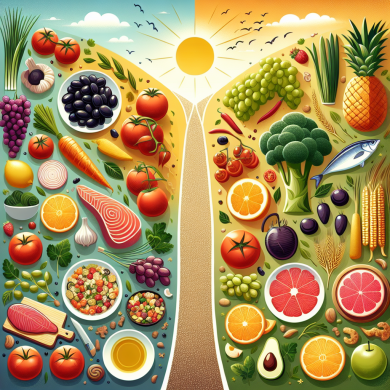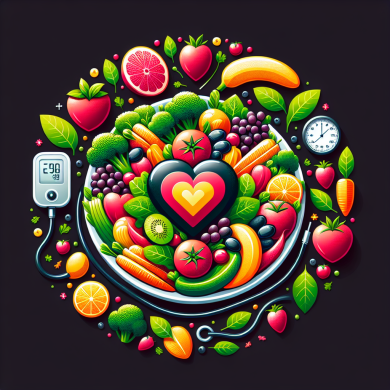Avoiding Pitfalls: Common DASH Diet Mistakes
Introduction
The Dietary Approaches to Stop Hypertension (DASH) diet is widely acclaimed for its effectiveness in lowering blood pressure and supporting cardiovascular health. It emphasizes the consumption of fruits, vegetables, whole grains, lean proteins, and low-fat dairy, while reducing the intake of sodium, saturated fats, and added sugars. Despite its well-documented benefits, there are common pitfalls that individuals may encounter while following the DASH diet. This article aims to highlight these mistakes, offering guidance on how to avoid them to ensure successful adherence and optimal health outcomes.
Misunderstanding the Role of Sodium
Overlooking Hidden Sources
The primary objective of the DASH diet is to reduce sodium intake to help manage blood pressure. However, many individuals fail to recognize hidden sources of sodium present in processed and packaged foods. Items such as canned soups, condiments, and frozen meals can contain high levels of sodium, undermining the diet’s effectiveness.
To avoid this pitfall, it is essential to read nutrition labels carefully and opt for products labeled as low-sodium or sodium-free. Additionally, preparing meals at home using fresh ingredients can significantly reduce sodium intake.
Exceeding Recommended Limits
An often-overlooked aspect of the DASH diet is adhering to the recommended sodium intake limits. Initially, the diet suggests a daily sodium intake of 2,300 milligrams, which can be further reduced to 1,500 milligrams for greater health benefits. Many individuals inadvertently exceed these limits, particularly when dining out.
It is advisable to plan meals and snacks to stay within these limits. Choosing restaurants that offer nutritional information or requesting dishes with no added salt can also help in maintaining appropriate sodium consumption.
Insufficient Intake of Fruits and Vegetables
Neglecting Variety
Fruits and vegetables form the cornerstone of the DASH diet, providing essential vitamins, minerals, and fiber. However, relying on a limited range of produce can result in nutrient deficiencies and reduced diet effectiveness.
To avoid this mistake, aim to incorporate a colorful variety of fruits and vegetables into your daily meals. This not only ensures a diverse nutrient intake but also keeps meals interesting and enjoyable.
Inadequate Portions
Another common error is consuming insufficient portions of fruits and vegetables. The DASH diet recommends 4-5 servings each of fruits and vegetables per day. Falling short of these recommendations can compromise the diet’s cardiovascular benefits.
To meet these requirements, consider adding an extra serving of fruit to your breakfast or including an additional vegetable side dish with lunch and dinner. Snacking on raw vegetables or fruit can also help achieve the necessary servings.
Overemphasis on Low-Fat and Non-Fat Products
Ignoring Nutrient Content
While the DASH diet encourages low-fat dairy and lean protein sources, an excessive focus on low-fat and non-fat products can lead to the consumption of foods high in added sugars and artificial ingredients. These additions can negate the diet’s health benefits.
To avoid this pitfall, prioritize whole, minimally processed foods. When selecting low-fat options, check the ingredient list for added sugars and choose products with minimal additives.
Forgetting Healthy Fats
Another mistake is neglecting healthy fats, which are crucial for overall health. The DASH diet includes healthy fats from sources such as nuts, seeds, avocados, and olive oil. These fats support cardiovascular health and enhance the absorption of fat-soluble vitamins.
Including moderate amounts of healthy fats in your diet can improve satiety and provide essential nutrients. Incorporate nuts and seeds into snacks or salads, and use olive oil for cooking and dressings.
Protein Pitfalls
Relying Too Much on Animal Protein
The DASH diet recommends lean proteins, but an overemphasis on animal sources, such as poultry and fish, can lead to excessive saturated fat intake. This can undermine the diet’s goal of reducing heart disease risk.
To balance protein intake, incorporate plant-based proteins such as beans, lentils, tofu, and quinoa. These options are low in saturated fat and high in fiber, enhancing the diet’s health benefits.
Ignoring Protein Diversity
A varied protein intake is essential for obtaining a comprehensive range of amino acids and nutrients. Relying on a limited number of protein sources can lead to nutritional imbalances.
To ensure diversity, rotate between different protein sources throughout the week. Experiment with different types of beans, nuts, seeds, and animal proteins to keep meals exciting and nutritionally balanced.
Misjudging Portion Sizes
Overeating Grains
Whole grains are an essential component of the DASH diet, providing fiber and essential nutrients. However, consuming large portions can lead to excessive calorie intake, potentially causing weight gain.
To avoid this mistake, adhere to recommended portion sizes of grains, which typically range from 6-8 servings per day, depending on individual caloric needs. A serving size is generally one slice of bread, 1/2 cup of cooked rice or pasta, or 1 ounce of dry cereal.
Underestimating Caloric Intake
While the DASH diet is not primarily focused on weight loss, managing caloric intake is crucial for maintaining a healthy weight. Many individuals underestimate the caloric content of foods, particularly when consuming large portions of calorie-dense foods like nuts and grains.
To better gauge caloric intake, consider using a food diary or mobile app to track meals and snacks. This can help ensure that calorie consumption aligns with individual health goals.
Neglecting Hydration
Confusing Thirst with Hunger
Proper hydration is an integral part of the DASH diet, yet many people mistake thirst for hunger, leading to unnecessary snacking and increased calorie intake.
To stay adequately hydrated, aim to drink at least eight 8-ounce glasses of water per day, more if you are physically active or in a hot climate. If you feel hungry, try drinking a glass of water first to determine if you are truly hungry or simply thirsty.
Relying on Sugary Beverages
It is common for individuals to consume sugary beverages such as sodas, juices, and energy drinks, which can add empty calories and sugar to the diet, counteracting the benefits of the DASH diet.
To avoid this pitfall, prioritize water, herbal teas, or other non-caloric beverages. If you enjoy flavored drinks, consider infusing water with fruits or herbs for a refreshing, low-calorie alternative.
Conclusion
The DASH diet offers a multitude of health benefits, particularly for cardiovascular health and blood pressure management. However, common mistakes can hinder its effectiveness. By understanding and avoiding pitfalls such as excessive sodium intake, insufficient fruit and vegetable consumption, and improper portion control, individuals can fully harness the power of the DASH diet. Through mindful eating and informed choices, it is possible to achieve improved health outcomes and long-term dietary success.















Add comment